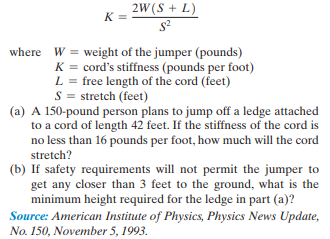2W(S + L) K = where W = weight of the jumper (pounds) K = cord's stiffness (pounds per foot) L = free length of the cord (feet) S = stretch (feet) (a) A 150-pound person plans to jump off a ledge attached to a cord of length 42 feet. If the stiffness of the cord is no less than 16 pounds per foot, how much will the cord stretch? (b) If safety requirements will not permit the jumper to get any closer than 3 feet to the ground, what is the minimum height required for the ledge in part (a)? Source: American Institute of Physics, Physics News Update, No. 150, November 5, 1993.
2W(S + L) K = where W = weight of the jumper (pounds) K = cord's stiffness (pounds per foot) L = free length of the cord (feet) S = stretch (feet) (a) A 150-pound person plans to jump off a ledge attached to a cord of length 42 feet. If the stiffness of the cord is no less than 16 pounds per foot, how much will the cord stretch? (b) If safety requirements will not permit the jumper to get any closer than 3 feet to the ground, what is the minimum height required for the ledge in part (a)? Source: American Institute of Physics, Physics News Update, No. 150, November 5, 1993.
University Physics Volume 1
18th Edition
ISBN:9781938168277
Author:William Moebs, Samuel J. Ling, Jeff Sanny
Publisher:William Moebs, Samuel J. Ling, Jeff Sanny
Chapter5: Newton's Law Of Motion
Section: Chapter Questions
Problem 89AP: In building a house, carpenters use nails from a large box. The box is suspended from a spring twice...
Related questions
Question
Bungee Jumping Originating on Pentecost Island in the
Pacific, the practice of a person jumping from a high place
harnessed to a flexible attachment was introduced to
Western culture in 1979 by the Oxford University Dangerous
Sport Club. One important parameter to know before
attempting a bungee jump is the amount the cord will stretch
at the bottom of the fall. The stiffness of the cord is related to
the amount of stretch by the equation

Transcribed Image Text:2W(S + L)
K =
where W = weight of the jumper (pounds)
K = cord's stiffness (pounds per foot)
L = free length of the cord (feet)
S = stretch (feet)
(a) A 150-pound person plans to jump off a ledge attached
to a cord of length 42 feet. If the stiffness of the cord is
no less than 16 pounds per foot, how much will the cord
stretch?
(b) If safety requirements will not permit the jumper to
get any closer than 3 feet to the ground, what is the
minimum height required for the ledge in part (a)?
Source: American Institute of Physics, Physics News Update,
No. 150, November 5, 1993.
Expert Solution
This question has been solved!
Explore an expertly crafted, step-by-step solution for a thorough understanding of key concepts.
This is a popular solution!
Trending now
This is a popular solution!
Step by step
Solved in 3 steps

Knowledge Booster
Learn more about
Need a deep-dive on the concept behind this application? Look no further. Learn more about this topic, physics and related others by exploring similar questions and additional content below.Recommended textbooks for you

University Physics Volume 1
Physics
ISBN:
9781938168277
Author:
William Moebs, Samuel J. Ling, Jeff Sanny
Publisher:
OpenStax - Rice University

College Physics
Physics
ISBN:
9781305952300
Author:
Raymond A. Serway, Chris Vuille
Publisher:
Cengage Learning

Principles of Physics: A Calculus-Based Text
Physics
ISBN:
9781133104261
Author:
Raymond A. Serway, John W. Jewett
Publisher:
Cengage Learning

University Physics Volume 1
Physics
ISBN:
9781938168277
Author:
William Moebs, Samuel J. Ling, Jeff Sanny
Publisher:
OpenStax - Rice University

College Physics
Physics
ISBN:
9781305952300
Author:
Raymond A. Serway, Chris Vuille
Publisher:
Cengage Learning

Principles of Physics: A Calculus-Based Text
Physics
ISBN:
9781133104261
Author:
Raymond A. Serway, John W. Jewett
Publisher:
Cengage Learning

Physics for Scientists and Engineers: Foundations…
Physics
ISBN:
9781133939146
Author:
Katz, Debora M.
Publisher:
Cengage Learning